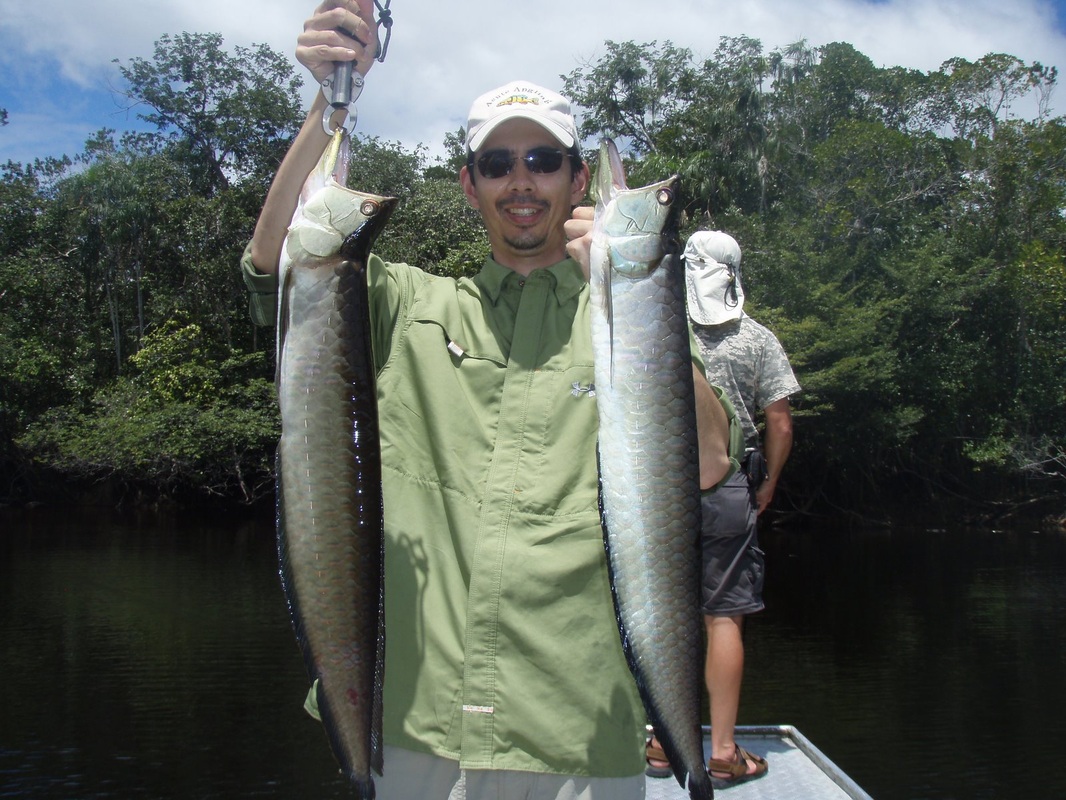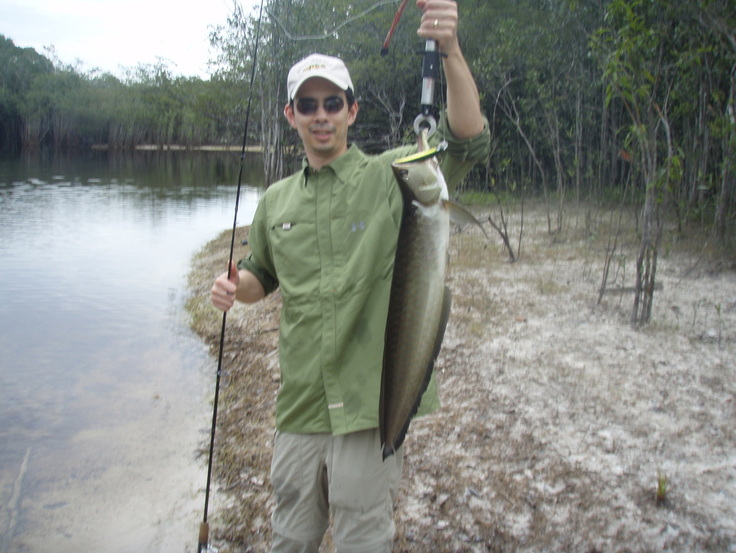| Freshwater Aquarium Fish_Arowana This page will give a completely detailed profile of the selected fish, from A to Z. The profiled fish will be chosen randomly by Badman, and will come from the complete genre of tropical fish. New profiles are added on a regular basis. If you would like to submit a profile for the site please contact me. Don't forget to let us know you experiences with this fish by filling out the  
Osteoglossum bicirrhossum
| |||||||||||||||||||||||
Overview:
Image gallery: Discuss: Distribution
General Body Form:
Coloration:
 Osteoglossum ferreirai Black Arowana Maintenance:
 Silver Arowana juveniles Biotope:
Breeding:
 | |||||||||||||||||||||||
Thứ Ba, 26 tháng 5, 2015
Freshwater Aquarium Fish_Arowana
Arowana Fishing - How To Catch Any Fish
Arowana (South American)
Osteoglossum bicirrhosum
Osteoglossum ferreirai
Arowana DescriptionArowanas are a family of long bony fishes found throughout the world. There are several species but this page will focus on the two found in South America - the Silver Arowana and the Black Arowana. They are similar in appearance and both reach over three feet in length. The Silvers grow a little faster than the Blacks but they have similar diets and habits. They are found in the Amazon and its tributaries. They are popular in the aquarium trade and are a relatively hardy and easy to keep fish if you have a large enough tank. See below for a pic of one I had in an aquarium for a few years.
Arowanas are surface oriented fish with eyes near the tops of their heads and they feed on things near the surface of the water. On occasion they will even leap out of the water to snatch small birds and insects. Their diet consists of smaller fish, insects, birds, and basically any other small creature that swims by and fits in their mouths.
Arowanas are generally caught as by catch by fishermen fishing for Peacock Bass. When hooked they put up a spirited fight for their size, generally leaping out of the water multiple times. They have tiny raspy teeth that won't easily bite through your line. Despite their large scales and bony appearance they are actually quite tasty.
Arowana TackleWhen fishing for Arowanas you can use fairly light spinning or baitcast tackle but since they generally live near other larger species like Peacock Bass you probably wouldn't want to. I like to fish with a 25lb fluorocarbon leader but I'm not sure it's necessary. I like the peace of mind of greater abrasion resistence though. Great reels for these are the Daiwa Steez and Daiwa Certate. recommendations.
Arowana Techniques
Arowanas are caught on both lures and bait, although in the Amazon they are primarily fished with lures. They can often be seen at the surface under the cover of overhanging trees and bushes.
Arowana LuresBecause of their surface orientation, small poppers work well. Shallow running jerkbaits such as the Yo-Zuri Crystal Minnow also work well when fished erratically. Arowanas are not shy and will generally attack most lures that resemble small fish and are twitched in front of their faces.
Arowana BaitsI have not done any bait fishing for Arowana. Small fish probably work well.
Where to get the big ArowanaThe Amazon river tributaries are where you get the big ones. The main river does not have a good fishery and many of the tributaries do not either. The best fisheries are generally slow-moving "blackwater" tributaries. You get a very short window in most areas to fish; usually just a few weeks per year. Most of the year the water level is too high and the water extends into the jungle. The fish head in there and become very spread out and very hard to catch. A good operator will cancel a trip at this point rather than let anglers suffer through poor fishing. The dry season concentrates the fish in a smaller area and makes them much easier to target. However, the dry season can (and nearly always does) vary from year to year in a particular area and rains during the dry season can raise water levels and make fishing tough. This fishery is tough to time but when you do it right it's amazing.
The Amazon fisheries are generally accessed in one of three ways: fixed lodge, mothership, or floating tents/camping. The fixed lodges can offer good fishing but if water levels are off, which they often are, you could be stuck catching few if any fish. Motherships offer more mobility to go where water levels are optimal, although in very dry conditions they may not be able to access all areas. Floating tents/camping offers the most mobility and therefore the best shot at hitting things at the right time. If the fishing is not good, you can move. There is really no way to fish these remote areas on the cheap as many are in restricted Indian reservations and you could be in serious trouble if you just tried to go in there on your own.
In general, the closer to the headwaters you get the less water fluctuation there is.
Guyana is supposed to have a good Arowana fishery but it is not a very developed destination.
Other Arowana Resources
If you want to catch any species in the Amazon, I recommend these guys: ey are reputable and their site has a wealth of information on Arowanas, Peacock Bass and other Amazon species.
Freshwater Aquarium Fish_Arowana information types feeding and care
Freshwater Aquarium Fish_Arowana information types feeding and care
If you'd like to do something a little different with your aquarium there are few fish more exotic than arowanas. Also known as dragonfish and bony tongues, they have traditionally been associated with dragons and thought to bring good luck and wealth.
Considering their striking appearance, with elegantly delineated scales and impressive barbels, it's easy to see why. Many arowana breeders participate in shows and competitions to celebrate the beauty of their fish.
Because of their aggressive temperament they should not be kept with fish much smaller than themselves, but they can get along well in community tanks with fish like cichlids, oscars and plecos.
They are sensitive to water condition, so you'll need good filtration. They also have a tendency to jump, so you'll need a secure aquarium hood.
Types of Arowanas
There are several species of arowana, originating from South America, Africa, Australia and Asia.Asian arowanas tend to be the most highly prized, but they are an endangered species and it is illegal to trade them in unless they are over thirty years old or captive bred (in which case they are marked with microchips).
- Silver Arowanas - These are the most common choice for aquarium hobbyists, but they are also the largest, sometimes growing to four feet in length.
- Black Arowanas -Almost identical to silver arowanas but for their colour, these fish are slightly less hardy.
- Australian Arowanas -These look very similar to their Asian equivalents but are far less expensive. Pearl and spotted varieties are available.
- African Arowanas -A distinctly different shape from other species, these fish are available in a variety of subtly blended colours.
Feeding and Care
All arowanas are carnivorous and strongly prefer live food.For best results they should be provided with a highly varied diet. Shrimp, prawns, mealworms, crickets, centipedes, krill and frogs are all suitable foods, though any sharp pieces should first be removed and live animals should be quarantined first to avoid the introduction of parasites.
Arowanas enjoy eating smaller fish but should not be fed these too often, as a build-up of fat in their bodies can lead to health problems. Many arowanas will take pellet food, but this is not sufficient on a daily basis.
Individual preferences vary, so be ready to experiment to see what your arowanas like.
Because arowanas are so active and tend to swim fast, you should avoid having any sharp objects in your aquarium on which they might injure themselves. Fast flowing water will keep them in better condition as it will discourage them from rubbing against the glass.
Arowanas in aquariums often suffer from protruding, drooping eyes due to looking downwards a lot, which they should not do in the wild.
A good way to avoid this is to keep a brightly coloured ping pong ball floating on the surface of the water. This will distract them sufficiently to keep their eyes in good condition and they'll enjoy playing with it, giving you something extra to enjoy watching.
Arowanas are extremely difficult to breed in captivity, especially in an aquarium. They spend months courting to develop pair bonds and spawn just once a year. If they do breed successfully, the male will protect the eggs, and later the fry, in his mouth. However, the female may eat them, so it is best to separate her at this stage.
Keeping arowanas can be a challenging experience and is not recommended for beginners, but once you know what you're doing you can derive a great deal of pleasure from getting to know these fascinating fish.
- See more at: http://www.allaquariuminfo.com/2011/11/arowana-information-types-feeding-and.html#sthash.KkYPgAlG.dpuf
Introduce More About Freshwater Aquarium Fish,how to animal and care for a most beautiful aquarium and relax after a hard working day You will feel more interesting when looking at them
Arowana fish
Freshwater Aquarium Fish_Arowana fish
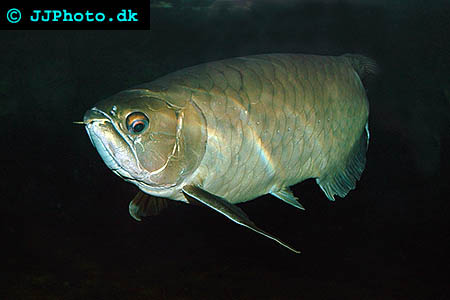
Asian Arowana - Scleropages formosus. Copyright www.jjphoto.dk
The Silver Arowana (Osteoglossum bicirrhosum) comes from the Amazon Basin. They can grow to around 48 inches in the wild, and are usually the cheapest Arowana species. Silver Arowana can be more jumpy then the other species and more than one Silver Arowana have jumped to their death in a badly covered aquarium.
Silver Arowana may take a while to adjust to non-live food. Sometimes to the brink of starvation. Feed them meaty food like, fish, crab, or Shrimp (try to avoid the salt). This Arowana Fish thrives in temperatures between 75 and 86 degrees Fahrenheit (24-30 C), and pH between 6 and 7. Young Silver Arowana should not be in a tank shorter then 36 inches/ 90 cm, and as they get older, 48 inches/ 120 cm though when your Arowana fish reaches 15 inches/ 40 cm they will need a much larger tank. These Arowana Fish can become aggressive towards similar species and should be kept alone in the aquarium tank unless it is very big. They can also be kept with larger catfish and a few other species. They are a definitely predator and will eat smaller fish. As juveniles, they may be suitable for smaller home aquarium, though with growth, they are likely to outgrow the home and become suitable only for large public aquariums.
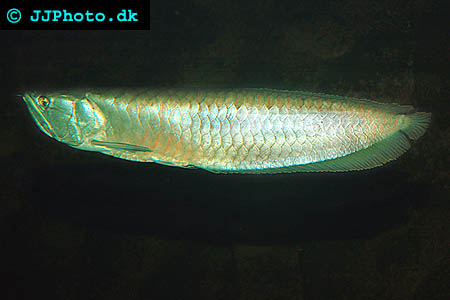
Silver Arowana - Osteoglossum bicirrhosum. Copyright www.jjphoto.dk
The Spotted Arowana (Scleropages leichardti) is mostly found from Southern Australia. They can grow to around 36 inches/ 90 cm (they do however only seldom reach this length in an aquarium), and are less sought after then the Asian Arowana. They are also called Dawson River Saratoga, Southern Saratoga, Spotted Barramundi, Australian Spotted Arowana, and Leichardti Saratoga. They tend to stay closer to the bottom than other Arowana fish species. This means that it sometimes is possible to keep them with Silver Arowana fish. As far as food, they are capable of eating most things that will fit their mouth (crickets, Hikari pellets, insects, etc). This Arowana fish species prefers a temperatures between 75 and 86 degrees Fahrenheit (24-30 C), and a pH level between 6.5 and 7.5. They may be territorial and aggressive.
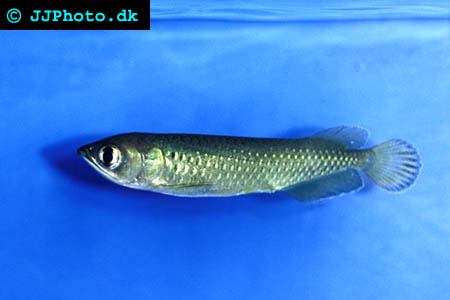
Spotted Arowana - Scleropages leichardtii. Copyright www.jjphoto.dk
The Northern Arowana (Scleropages jardini) is found mostly in Northern Australia. They can grow to around 36 inches/ 90 cm. They are also called Northern Saratoga, Jardine Saratoga, Gulf Saratoga, Australian Gold or Pearl Arowana and Jardini Saratoga. They eat similar food as the Spotted Arowana (Southern Australia), and are less likely to jump out of the tank than other species (though they might). This variety of Arowana Fish is best kept at a pH level of 6.0 - 7.5 and temperatures of 72 to 80 degrees Fahrenheit (22-27 C). While less aggressive then others, they are still predators and will likely eat anything that will fit in their mouths. They will eat Crayfish, Fish, Insects, and pellets with a little effort to get them started.
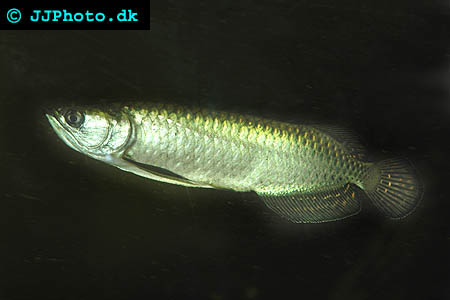
Northern Arowana - Scleropages jardinii. Copyright www.jjphoto.dk
The African Arowana (Heterotis niloticus) comes from western and central Africa. They grow up to around 40 inches/100 cm. They are more rare than other Arowana Fish species. They are predators known to eat small fish. This Arowana Fish prefers temperatures between 75 and 86 degrees Fahrenheit (24-30 C) and a pH level of 6.7 to 7.5 (7.0 preferred). They eat shrimp, fish, live worms, and insects in captivity.
The Black Arowana fish (Osteoglossum ferreirai) comes from South America in the Rio Negro basin. They grow up to around 40 inches / 100 com, though they seldom reach this length in captivity. The Black Arowana fish eat live fish, large insects, spiders, Tubifex worms, and may also eat pellets and flakes (not all specimens accept pellets and flakes). Young Arowana fish of this species tend to be delicate, though older fish tend to be more hardy. They prefer a pH level of 5-7 with 6.4 being the optimum level, and temperatures between 75 and 86 degrees Fahrenheit (24-30 C).
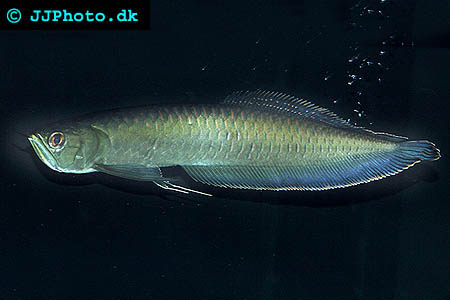
ntroduce More About Freshwater Aquarium Fish,how to animal and care for a most beautiful aquarium and relax after a hard working day You will feel more interesting when looking at them
Arowana Fish (sometimes called dragon fish) can be a great choice for those that think big. Some varieties can grow up to Four feet long (120cm). They can be feisty, though become tamer with age to the point of eating from your fingers, and not the fingers themselves. The Arowana Fish comes from somewhat primitive origins (Jurassic Age), and some varieties are nicknamed “Bony Tongued Fish”.
Arowana fish are carnivores, though will generally eat nearly anything. Young Arowana Fish may be fed frozen or live brine shrimp, black worms, and even small fish. When older, some larger fish will do. Baby Arowana Fish should be fed maybe 3 times a day, medium sized twice a day, and adults once a day, or even once every other day. Variety is important for a well balanced diet in Arowana Fish just like for most other fish.
The Arowana eating habits produce a lot of waste and you should therefore, pay extra attention to water conditions (Ammonia, Nitrite, and Nitrate) in your aquarium. Changing 25% to 33% of the water weekly is advisable, or better yet, 20% twice a week. You should maintain the pH neutral. Pay particular attention to the temperature and pH ranges suggested below on the various species, since if you have it too warm, it might cause them to age faster, look less Arowana, and even shorten their life. A to cold temperature might on the other hand kill them.
Generally, a good healthy Arowana Fish will grow to be at least 24 to 30 inches (60-75cm). Some varieties can become 48 inches (120 cm) in the wild. They may be aggressive (definitely not good community fish), and Arowana fish can sometimes be best kept alone in an aquarium. Remember that other smaller fish in the tank may become their dinner.
Arowana fish will often swim in the top of the aquarium, and are capable of jumping from the aquarium. Keep the aquarium well covered to avoid coming home to a dead pet. Silver Arowana Fish in the wild have been known to jump at insects in trees.
Arowana Fish may live for many years, and if well cared for Arowana fish may live longer than 20 years in captivity. If you keep the aquarium temperature towards the lower end, they may look young longer than they would in a higher temperaturel. Please pay particular attention to each Arowana Fish’s needs below.
The Asian Arowana or Golden Arowana (Scleropages formosus) is considered an endangered species. Care should be taken to follow the law in purchasing and transporting them. Asian Arowana fish generally can grow to about 36 inches, and are often much more expensive then the other Arowana species. These are well known and popular South East Asia where they are believed to bring luck. Feeding them healthy Guppies, Gold Fish, Frogs, or Shrimp makes a good stable diet. The temperature is best kept between 75 and 86 degrees Fahrenheit (24-30 C), and a pH level between 7.0 and 7.5 are advisable.
Arowana fish are carnivores, though will generally eat nearly anything. Young Arowana Fish may be fed frozen or live brine shrimp, black worms, and even small fish. When older, some larger fish will do. Baby Arowana Fish should be fed maybe 3 times a day, medium sized twice a day, and adults once a day, or even once every other day. Variety is important for a well balanced diet in Arowana Fish just like for most other fish.
The Arowana eating habits produce a lot of waste and you should therefore, pay extra attention to water conditions (Ammonia, Nitrite, and Nitrate) in your aquarium. Changing 25% to 33% of the water weekly is advisable, or better yet, 20% twice a week. You should maintain the pH neutral. Pay particular attention to the temperature and pH ranges suggested below on the various species, since if you have it too warm, it might cause them to age faster, look less Arowana, and even shorten their life. A to cold temperature might on the other hand kill them.
Generally, a good healthy Arowana Fish will grow to be at least 24 to 30 inches (60-75cm). Some varieties can become 48 inches (120 cm) in the wild. They may be aggressive (definitely not good community fish), and Arowana fish can sometimes be best kept alone in an aquarium. Remember that other smaller fish in the tank may become their dinner.
Arowana fish will often swim in the top of the aquarium, and are capable of jumping from the aquarium. Keep the aquarium well covered to avoid coming home to a dead pet. Silver Arowana Fish in the wild have been known to jump at insects in trees.
Arowana Fish may live for many years, and if well cared for Arowana fish may live longer than 20 years in captivity. If you keep the aquarium temperature towards the lower end, they may look young longer than they would in a higher temperaturel. Please pay particular attention to each Arowana Fish’s needs below.
The Asian Arowana or Golden Arowana (Scleropages formosus) is considered an endangered species. Care should be taken to follow the law in purchasing and transporting them. Asian Arowana fish generally can grow to about 36 inches, and are often much more expensive then the other Arowana species. These are well known and popular South East Asia where they are believed to bring luck. Feeding them healthy Guppies, Gold Fish, Frogs, or Shrimp makes a good stable diet. The temperature is best kept between 75 and 86 degrees Fahrenheit (24-30 C), and a pH level between 7.0 and 7.5 are advisable.

Asian Arowana - Scleropages formosus. Copyright www.jjphoto.dk
The Silver Arowana (Osteoglossum bicirrhosum) comes from the Amazon Basin. They can grow to around 48 inches in the wild, and are usually the cheapest Arowana species. Silver Arowana can be more jumpy then the other species and more than one Silver Arowana have jumped to their death in a badly covered aquarium.
Silver Arowana may take a while to adjust to non-live food. Sometimes to the brink of starvation. Feed them meaty food like, fish, crab, or Shrimp (try to avoid the salt). This Arowana Fish thrives in temperatures between 75 and 86 degrees Fahrenheit (24-30 C), and pH between 6 and 7. Young Silver Arowana should not be in a tank shorter then 36 inches/ 90 cm, and as they get older, 48 inches/ 120 cm though when your Arowana fish reaches 15 inches/ 40 cm they will need a much larger tank. These Arowana Fish can become aggressive towards similar species and should be kept alone in the aquarium tank unless it is very big. They can also be kept with larger catfish and a few other species. They are a definitely predator and will eat smaller fish. As juveniles, they may be suitable for smaller home aquarium, though with growth, they are likely to outgrow the home and become suitable only for large public aquariums.

Silver Arowana - Osteoglossum bicirrhosum. Copyright www.jjphoto.dk
The Spotted Arowana (Scleropages leichardti) is mostly found from Southern Australia. They can grow to around 36 inches/ 90 cm (they do however only seldom reach this length in an aquarium), and are less sought after then the Asian Arowana. They are also called Dawson River Saratoga, Southern Saratoga, Spotted Barramundi, Australian Spotted Arowana, and Leichardti Saratoga. They tend to stay closer to the bottom than other Arowana fish species. This means that it sometimes is possible to keep them with Silver Arowana fish. As far as food, they are capable of eating most things that will fit their mouth (crickets, Hikari pellets, insects, etc). This Arowana fish species prefers a temperatures between 75 and 86 degrees Fahrenheit (24-30 C), and a pH level between 6.5 and 7.5. They may be territorial and aggressive.

Spotted Arowana - Scleropages leichardtii. Copyright www.jjphoto.dk
The Northern Arowana (Scleropages jardini) is found mostly in Northern Australia. They can grow to around 36 inches/ 90 cm. They are also called Northern Saratoga, Jardine Saratoga, Gulf Saratoga, Australian Gold or Pearl Arowana and Jardini Saratoga. They eat similar food as the Spotted Arowana (Southern Australia), and are less likely to jump out of the tank than other species (though they might). This variety of Arowana Fish is best kept at a pH level of 6.0 - 7.5 and temperatures of 72 to 80 degrees Fahrenheit (22-27 C). While less aggressive then others, they are still predators and will likely eat anything that will fit in their mouths. They will eat Crayfish, Fish, Insects, and pellets with a little effort to get them started.

Northern Arowana - Scleropages jardinii. Copyright www.jjphoto.dk
The African Arowana (Heterotis niloticus) comes from western and central Africa. They grow up to around 40 inches/100 cm. They are more rare than other Arowana Fish species. They are predators known to eat small fish. This Arowana Fish prefers temperatures between 75 and 86 degrees Fahrenheit (24-30 C) and a pH level of 6.7 to 7.5 (7.0 preferred). They eat shrimp, fish, live worms, and insects in captivity.
The Black Arowana fish (Osteoglossum ferreirai) comes from South America in the Rio Negro basin. They grow up to around 40 inches / 100 com, though they seldom reach this length in captivity. The Black Arowana fish eat live fish, large insects, spiders, Tubifex worms, and may also eat pellets and flakes (not all specimens accept pellets and flakes). Young Arowana fish of this species tend to be delicate, though older fish tend to be more hardy. They prefer a pH level of 5-7 with 6.4 being the optimum level, and temperatures between 75 and 86 degrees Fahrenheit (24-30 C).

Thứ Hai, 25 tháng 5, 2015
Freshwater Aquarium Fish_flowerhorns spots
Freshwater Aquarium Fish_flowerhorns spots

History
Thus far very few or no scientific documentation studied about the genetics history of flowerhorn cichlids. They are known as hybrid species whose parents were believed to be South American cichlids. Some hobbyists may agree that flowerhorns were developed or bred by a group of Malaysians in the late 1900's, whereas others may not necessarily believe so. Theoretically, flowerhorns were the result of cross breeding between different types of South American cichlids. The theory of cross breeding were to combine the good strains from each parents, i.e., body shapes, humps, color, etc. Although not all breeders were successfully crossbred flowerhorns, many of them had produced some very rare strains. Initially, the breeding techniques and the parents of flowerhorns were kept secret due to business purposes.
For quite a long time, flowerhorns were believed to be fish of luck. Very few of them developed Chinese characters on the humps and sides. Some people believe that underneath the chin of flowerhorns represents a bank of treasure, which bring luck to the owners. Different people had different believe on flowerhorns. In addition to their beauty, the belief in luck on the flowerhorns made them very expensive in the late 1900's and early 2000. Most folowerhorn owners during that time were mostly upper class, wealthy families, and small entrepreneurs. That was one flowerhorn could cost up to $1,00.00 or more. Therefore, many breeders take that opportunity to build flowerhorn farms and ran small business by selling flowerhorns.
In the past several years, flowerhorns were brought into the United States and were popular among Asian Americans. As the popularity of flowerhorns caught the interest of other fish hobbyists in America, small businesses, i.e., local fish stores developed. These stores imported flowerhorns to the United States and sold locally. As the numbers of this business increased, people began to see flowerhorns sold on eBay and other online stores.
Today flowerhorns are not as expensive as in the late 1900's due to a few reasons: (1) many breeders entered the market and resulted in increasing the number of flowerhorns, (2) most flowerhorn hobbyists were successfully bred flowerhorns on their own, and (3) flowerhorn are easy to export or import from country to country within 48 hours or overnight. Now most people raise flowerhorns for a hobby instead of the belief that flowerhorns are fish of luck.
For quite a long time, flowerhorns were believed to be fish of luck. Very few of them developed Chinese characters on the humps and sides. Some people believe that underneath the chin of flowerhorns represents a bank of treasure, which bring luck to the owners. Different people had different believe on flowerhorns. In addition to their beauty, the belief in luck on the flowerhorns made them very expensive in the late 1900's and early 2000. Most folowerhorn owners during that time were mostly upper class, wealthy families, and small entrepreneurs. That was one flowerhorn could cost up to $1,00.00 or more. Therefore, many breeders take that opportunity to build flowerhorn farms and ran small business by selling flowerhorns.
In the past several years, flowerhorns were brought into the United States and were popular among Asian Americans. As the popularity of flowerhorns caught the interest of other fish hobbyists in America, small businesses, i.e., local fish stores developed. These stores imported flowerhorns to the United States and sold locally. As the numbers of this business increased, people began to see flowerhorns sold on eBay and other online stores.
Today flowerhorns are not as expensive as in the late 1900's due to a few reasons: (1) many breeders entered the market and resulted in increasing the number of flowerhorns, (2) most flowerhorn hobbyists were successfully bred flowerhorns on their own, and (3) flowerhorn are easy to export or import from country to country within 48 hours or overnight. Now most people raise flowerhorns for a hobby instead of the belief that flowerhorns are fish of luck.
Flowerhorns are most popular among young people between the ages of 15 - 35 years old. Most flowerhorn hobbyists are males. Recently, very few females and older males began to raise flowerhorns.
Why is it called Flowerhorn?
 "Flowerhorn" is a common name for this species. They received the name "Flowerhorn" from their physical appearance. The word "Flower" came from the two black spots on both sides of their heads or humps, as demonstrated on the picture on the right. The word "horn" came from the hump. Most babies (fries) or young flowerhorns do not have a hump. As they grow adult, they will develop a hump and the two black spots on the side of the head spread out look like two-dimensional flowers. Therefore, combining the two words came with the name "Flowerhorn." However, not all flowerhorns have humps and flowers. Some flowerhorns have very big humps; some have small humps, and other have almost no hump. Like wise, some have flowers whereas the others do not. Nevertheless, they fall into same category—Flowerhorns.
"Flowerhorn" is a common name for this species. They received the name "Flowerhorn" from their physical appearance. The word "Flower" came from the two black spots on both sides of their heads or humps, as demonstrated on the picture on the right. The word "horn" came from the hump. Most babies (fries) or young flowerhorns do not have a hump. As they grow adult, they will develop a hump and the two black spots on the side of the head spread out look like two-dimensional flowers. Therefore, combining the two words came with the name "Flowerhorn." However, not all flowerhorns have humps and flowers. Some flowerhorns have very big humps; some have small humps, and other have almost no hump. Like wise, some have flowers whereas the others do not. Nevertheless, they fall into same category—Flowerhorns.
Introduce More About Freshwater Aquarium Fish,how to animal and care for a most beautiful aquarium and relax after a hard working day You will feel more interesting when looking at them
How to Care for Red Dragon Flowerhorns
Simple Tips for Enhancing Red Dragon Flowerhorns
The red dragon flowerhorn is one of the very first Lou Hans I kept. As with other flowerhorns belonging to the Zen Zhou category, the red dragon is unbelievably very easy to enhance and care for. If you are a newbie to this hobby, I suggest keeping this strain or any strain belonging to the Zen Zhou category.
In this post, I will discuss with you everything you need to know on how to care for red dragon flowerhorns. Even if you have very limited experience keeping fishes, I guarantee that by following the tips below, you will do just fine in keeping these hardy cichlids.
Choosing the Right Fish
Health, above anything else, should be your primary consideration when choosing a red dragon. Fish should be free of defects, have no visible signs of disease, and should swim just fine.
When it comes to buying flowerhorns, it’s better to buy a better quality fish even if the price is a bit higher. In my experience, it’s almost always better buying a single high quality fish at premium price than buying a few low quality ones at bargain price with the hope that they will turn out beautiful once enhanced. Check out my other post for a more detailed discussion about the traits, pricing, and origin of the red dragon flowerhorn.
Preparing the Tank
A 50-gallon tank would suffice for most red dragons aging two years or less. In fact, these may serve them just enough for their entire lifetime. Unlike many classic Lou Hans, new strains normally don’t grow as large. However, you should still observe the growth rate of your fish as it’s not uncommon for many new red dragons to grow to a fuller size. If you think your fish is already having trouble moving around its tank, you definitely should get it a much larger tank.
If you prefer buying a juvenile fish that you could rear until they achieve their best potential, I suggest using a 50-gallon tank until they reach 6-8 inches in size. If you think your fish is still growing, buy it a larger tank. A 70-gallon tank is the smallest in this case. Or you could just use a 70-gallon tank right away. With these fast-growing cichlids, bigger tanks are always better. Read more about this topic on our guide on flowerhorn tank sizes.
Comprehensive Feeding Guide
The red dragon flowerhorn would eagerly consume any fish food designed for cichlids and they would just do fine. If you however want to enhance your pet to achieve its full potentials, provide it with fish food that are rich in Astaxanthin, preferably those derived from natural ingredients like krill. Personally, I stay away from synthetic astaxanthin. In my experience, they make fish develop redness much faster but there effects are not as long-lasting and as vibrant as with fish food containing natural enhancers.
At their growth years provide them with high protein fish food, but slowly shift to those containing more vegetable matter as they grow older. Personally, I believe that this will help you fish live longer. Always check that they are not very fat and overfed as this is the biggest reason for poor health. The growth rate of the red dragon flowerhorn typically starts to decline as they reach six inches. I think that’s the right time to SLOWLY shift to fish food containing less protein and more fiber and spirulina. Read more on food for flowerhorn head growth.
Keeping Your Fish Healthy
Flowerhorns are voracious eaters so it’s expected that they would produce a lot of waste. Keep you fish healthy by following a strict feeding routine. Again, NEVER overfeed.
Religiously follow a water change routine. Red dragons unlike many Kamfa are not as susceptible to the bad effects of water change and may in fact benefit from it more if done frequently. You don’t have to remove the fish from the tank. Just siphon waste along with 30% tank water and replace with aged water. Do this every week or two.
Provide your fish with properly lighting as well. Check out our guide on flowerhorn lighting
Provide your fish with properly lighting as well. Check out our guide on flowerhorn lighting
The Flowerhorn fish - Proper care, Breeding, Pictures & Forum
The Flowerhorn fish - Proper care, Breeding, Pictures & Forum
Brief Description
This page is an ultimate guide on raising Flowerhorns with plenty of information from fish keepers, forum, pictures and answers including how to enhance hump growth! However we also have another page devoted to the Flowerhorn fish andyou should visit it too: Flowerhorn profile with forum. Both, this page and the link are worth reading especially when you want to learn from others. We'd love to hear about your Flowerhorn too, so use a form at the bottom of this page once you're finished reading this article, please!Introduction
The Flowerhorn fish is also known with the Chinese common name Hua Luo Han; this fish does not exist in nature but it is a hybrid result of various cross-breeding of South America cichlids, in fact it can be listed under the Cichlasoma genus, even if the starting breeders are unknown, the most of people think about Cichlasoma Trimaculatus, C. Festae, Red Parrot cichlid, Jingang and other fish.
Information about care
Flowerhorn cichlid is a big fish with compact body, it can reach 30 cm (11.81 inch) in length and sometimes can grow even bigger. Intensive breeding has created a very peculiar fish that is becoming really famous and relatively common in the last few years; moreover breeders keep on trying to improve the fish qualities focusing on bigger hump on the head, new and better colours, wider body and fins, more peculiar black marks on the body, without the employ of chemical and artificial factors. For the importance of appearance, a good Flowerhorn must follow a standard that defines various aspects of its body:
- General body: the fish body must be oval and thick, with full belly and stomach; some new variants have anyway a more rounded shape.
- Hump: the hump on the forehead should be big and well proportioned to the fish size.
- Black marks: it is important that the marks are thick and well defined, this is one of the principal characteristic of Flowerhorn, anyway some new varieties do not give too much importance to them.
- Overall Colouration: the most common Flowerhorn have a predominant red colouration, anyway every colour should be bright and well defined.
- Scales: the entire body should be covered by light blue or green scales.
- Fins: both tails and fins should be widely spread the most of time.
Aquarium set-up information
Due the big size they can reach, Flowerhorn need big aquarium with a lot of free space for swimming; a 200 liters (52.83 US gallon, 43.99 Imperial gallon) tank is the minimum you can offer to an adult fish to let it live healthily. It is a really strong fish and can live in different water conditions without having problems, anyway it is important to provide a temperature between 25°C (77°F) and 30°C (86°F); pH value is also important, because acid water can tone down fish colours and make it sick, the ideal condition is a light alkaline water, with a pH between 7 and 8. Moreover it is necessary to avoid sudden condition changes of temperature and chemical values, because they can make Flowerhorn being more sensible to sickness like bacteria attacks.
Water filtration is really important because this big fish produces lots of refuses that end increasing nitrite and nitrate levels in the water. You can choose both internal and external filtration, even if the second one is preferred to leave more free space to the fish. The biological part must work properly, so be sure to have a well activated aquarium before to house a Flowerhorn cichlid.
Take also a look to the water current, an excessively strong one can damage the fish, anyway it is important that a slow movement is present, because it oxygenates the water, and avoids that the water heats only near heater.
Tank decorations are important to make the fish feel quieter. Use a layer of fine gravel and be sure that rocks and woods are stable and do not risk to fall easily on the fish; be sure, as well, that all the decorations do not make the tank cleaning too much difficult. Live plants are important for filtration and oxygenation, anyway choose strong plants like big anubias, because any Flowerhorn cichlid use to dig a lot; you can also use plastic plants, even if they are not useful and you can risk that the fish accidentally eat them.
Being big and aggressive is better not to house it with other fish species, specially if they are smaller. While if you plan to house more than one Flowerhorn, provide a big tank and divide it with accessories to let fish divide the territory; to avoid fights it is recommended not to keep more than two or three fish together in the same tank.
Pictures
Feeding
Flowerhorn like similar sized fish, astronotus ocellatus for example, need a live food integration to be healthy and in shape. Their diet can consist of live food, frozen food, and standard dry fish food. The live food should be of good dimension, or the fish could not notice it, earth worms and big meal worms or wax worm are accepted; moreover you can give small fish, Poecilia reticulata could be a good choice since the high number of fry they spare monthly. Remember to feed every live food you choose, and in case of live fish be sure they are healthy.
Frozen food is another good solution, especially when you do not have the live one. Young Flowerhorn usually eat chironomus, brine shrimps and other frozen fish foods, while older ones could not notice them; at their place you can offer frozen fish for human use, you have a great choice, anyway if possible get freshwater fish and avoid the sea ones.
Both live and frozen food can pollute the water, so be sure that Flowerhorn eats all the given food in 5 minutes maximum, in case of rests remove them fast; for this reason it is better to have an aquarium set up that allow you to clean fast without needing to move objects.
Dry standard fish food is a good complementary option, especially if it is of good quality. You can find special food produced for cichlids that usually consist of big pellets that Flowerhorn like.
A Flowerhorn cichlid should be fed two times a day, everyday, anyway be careful with the quantities and avoid to overfeed it, reducing the food amount specially if it is really rich of nutrients.
Breeding and care for the fry
Sexing Flowerhorn is quite easy, especially when they have reached the length of 10 cm – 12 cm (3.94 - 4.72 inch). The anal pore of the fish has a V shape in case of males and a U shape in case of females. Moreover females tend to have a smaller hump when adults.
Being cichlids their reproduction can be similar to the cichlasoma one. The female lays eggs on a flat surface, like a rock or the aquarium glass and take care of them, while the male keeps other fish away. After 3 or 4 days the fry hatch and parents take care of them moving in more secure hiding places. You can feed them with just hatched brine shrimps and other specific food for fry.
Breeding is not so easy because female can be easily stressed or worried and ends up eating her eggs, anyway if the environment is quiet and the parents are healthy reproduction is possible.
Special thanks goes to Bien Gutierrez who has allowed us to use his picture.
More pictures of Flowerhorn
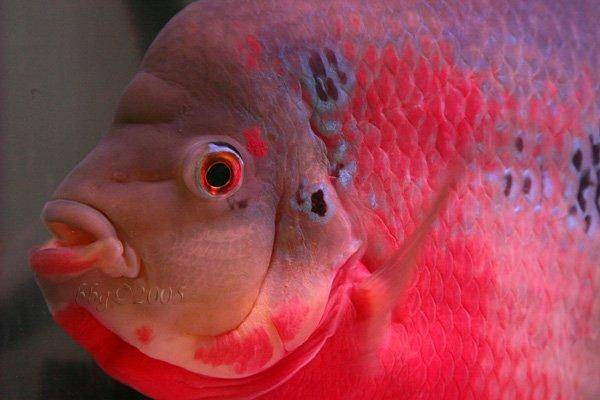
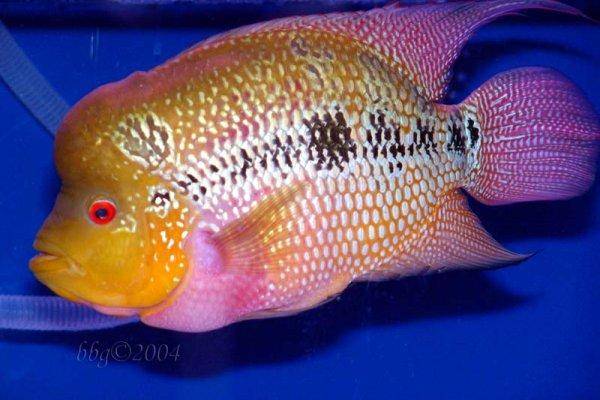
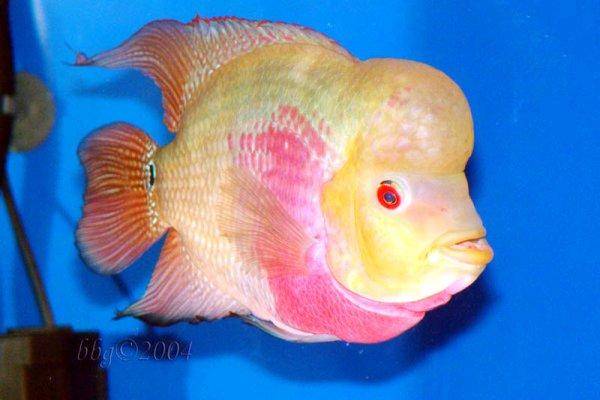
Introduce More About Freshwater Aquarium Fish,how to animal and care for a most beautiful aquarium and relax after a hard working day You will feel more interesting when looking at them
Freshwater Aquarium Fish_Flowerhorn Cichlid
Freshwater Aquarium Fish_Flowerhorn Cichlid
The Flowerhorn Cichlid is a great fish for those who are looking for a unique and large cichlid. This fish has a great personality and is very interested in its environment. Those who purchase them fall in love.
This hybrid is jone of the most eye catching results of cichlid interbreeding, and has created quite a stir in the aquarium hobby. Cichlids tend to not be picky breeders and will breed with another fish of the opposite sex whether it is of the same species or just another cichlid. This promiscousity has resulted in the development of a large variety of cichlid hybrids, oftentimes with amazing results.
Unlike the beginnings of the now popular Blood Parrot hybrid, the development of the gorgeous Flowerhorn Cichlid was not accidental. However, like the Blood Parrot, the Flowerhorn Cichlid is a man-made creation and is not found in the wild. The development of the Flowerhorn came from the deliberate cross breeding of many types of cichlids by Malaysian fishkeepers. The Flowerhorn has been carefully bred and blood lines meticulously not crossed in order to produce a healthy fish. In part because of this careful and selective breeding regime, this particular hybrid lacks the physical ailments plaguing many of the other cichlid hybrids and is even fertile, an uncommon trait amongst hybrids.
One interesting feature of the Flowerhorn Cichlid is that its coloring and patterning are fluid and will change and evolve until it becomes a fully mature adult. Thus, if you are interested in a particular look or pattern for your fish, you should be wary of purchasing a juvenile or a less than fully mature specimen. Alternatively, if you choose to purchase a young fish, you can look forward to watching its color and patterning develop almost literally right before your eyes. It's always an interesting surprise to see where their aesthetics end up! One other thing to note, however, is that in part because of this uncertainty juveniles tend to be far less expensive than mature adults. So it may be advantageous to buy the cheaper and less certain fish, rather than the expensive and unchanging fish. Either way, these fish are always beautiful and a great pet to own!
These cichlids are easy to care for and tend to be very hardy fish. That being said, they typically grow to between 12 - 16 inches (31 - 41 cm) and will require a fairly large tank of at least 55 gallons, and much larger if you plan on keeping them with tankmates. They appreciate having some rocks to hide behind but will spend most of their time out in the open. They love to dig in the substrate and will eat any living plant in their aquarium, so plants won't do well in their tank.Because they have such an affinity for digging and because due to their large size they are able to move significant amounts of substrate, it's recommended that any rocks or decorations in the tank br placed firmly on the glass bottom of the aquarium and not be reliant on gravel or sand for their footing. Otherwise you may wake up one morning to find your carefully arranged tank in complete disarray. Be sure to allow plenty of room for open swimming.
The Flowerhorn Cichlid is best kept singly as a show fish. They are very territorial and aggressive, so they should not be kept in a community tank (unless the tank is very large such as 200 gallons or more) and any tankmates should be monitored closely for signs of injury or stress. As a matter of fact, they are even knonw to hands and can cause lacerations and marks on human skin. Keeping other fish out of its 'line of sight' will help to lower aggression, so decorate in a way that provides natural borders for its territory.
Freshwater Aquarium Fish_Basics of flower horn fish keeing
Freshwater Aquarium Fish_Basics of flower horn fish keeing
This article below is a basic guide on keeping flower horn fish. It has been compiled by our experienced breeders. Be aware that there may be some information which are not available. If you have further questions, please do not hesitate to contact us.
Temperature
Like most tropical fish, flower horn thrives in temperature between 20-30°C. Ideal or recommended temperature will be around 28-31°C.
Water Condition
One of the important criteria in flower horn fish keeping is the pH level of the water the it lives in. pH level is actually the measure of acidity or alkaline of the water. The pH scales ranges from 0 to 14. Flower horn fish requires moderately alkaline water, ideally between 7.5 to 8.0. In order to maintain stable water conditions, it is advisable to have a regular water change interval of once a week. It is also advisable to mix a portion of crushed coral with the gravel. This will further maintain pH stability. Like any other fish, sudden or drastic changes on the pH level can be detrimental to the flower horn fish. As precaution, it will be great to check the pH of the water periodically.
Filtration System
On the overall, flower horn fish is easily maintained. No doubt that it is a hardy breed. But to bring out the best of the fish (be it coloration, nuchal hump and overall health), we should incorporate an efficient filtration system. There are quite a number of filtration systems in the market. Ideally the filtration s
ystem should have these criteria:
• Easily cleaned
• Efficient mechanical pre-filter
• A biological system that is protected from clogging
Last but not least, regular / periodic partial water changes is also important.
Water Change
For some hobbyist, water change is a chore that they dreaded most. In order to have a well maintained tank, periodic partial water change should be done at least once a month. Be aware that clear water with stable water pH and excellence water temperature does not indicate that the water in the tank is clean. Besides, there is no filtration system that is able to keep the tank 100% clean. Furthermore, regular water change will ensure the growth and health of the fish. Be doubly aware that regular topping up of the water in the tank does not count as water evaporates. The waste from the fish still stays behind.
Water Movement / Flow
Most of the time, the flow of the water in the tank is overlooked by hobbyist. But it is vital to the health of the fish.
Below are some of the important factors:
• Alleviate the possibility of thermal layering. In other words, uneven distribution of water temperature.
• It also helps to distribute oxygenated water in the tank.
• It prevents the formation of thin film on the water surface that will hinder the gaseous exchange between air and water in the tank.
Salt and its Benefits
Salt at times acts like a stabilizer. But in some areas, the dissolved salt content in the water is low, and the addition of aquarium salt might simply make the fish feel more “at home”. It acts like a disinfectant as it helps in killing certain parasites. Salt also provides sodium and chloride ions that helps fish stabilize.
Feeding
Flower horn fish has very good appetite. This hybrid can either take live food or fish pellets. It is advisable to feed the fish several times a day in small quantity. Ideally to have a mixture of life and fish feed. This will make the fish healthier. Besides, the intensity of coloration greatly depends on the diet of the fish. Excessive feeding of color enhancer is not advisable as it may contain harmful chemicals. Please do it in moderation.
Tank Environment
In general, it is important that we provide some furnishings for the fish. The intent is to stabilize and make it feel more at home. All that is required by flower horn fish is to have a thin layer of gravel in the tank. Bare in mind that stressed fish will cause the fish to loose its coloration, nuchal hump and may stun its growth.
Basic Traits
As flower horn fish is from the South American Cichlid family (under the genus Cichlasoma), this fish is very aggressive and territorial in nature. Coexisting with other fish is not advisable. Thus, if you plan to have 2 or more fish in a tank, it is a requirement that you have the tank partitioned. This will prevent the fish from fighting that may lead to even death.
Like most tropical fish, flower horn thrives in temperature between 20-30°C. Ideal or recommended temperature will be around 28-31°C.
One of the important criteria in flower horn fish keeping is the pH level of the water the it lives in. pH level is actually the measure of acidity or alkaline of the water. The pH scales ranges from 0 to 14. Flower horn fish requires moderately alkaline water, ideally between 7.5 to 8.0. In order to maintain stable water conditions, it is advisable to have a regular water change interval of once a week. It is also advisable to mix a portion of crushed coral with the gravel. This will further maintain pH stability. Like any other fish, sudden or drastic changes on the pH level can be detrimental to the flower horn fish. As precaution, it will be great to check the pH of the water periodically.
On the overall, flower horn fish is easily maintained. No doubt that it is a hardy breed. But to bring out the best of the fish (be it coloration, nuchal hump and overall health), we should incorporate an efficient filtration system. There are quite a number of filtration systems in the market. Ideally the filtration s
• Easily cleaned
• Efficient mechanical pre-filter
• A biological system that is protected from clogging
Last but not least, regular / periodic partial water changes is also important.
For some hobbyist, water change is a chore that they dreaded most. In order to have a well maintained tank, periodic partial water change should be done at least once a month. Be aware that clear water with stable water pH and excellence water temperature does not indicate that the water in the tank is clean. Besides, there is no filtration system that is able to keep the tank 100% clean. Furthermore, regular water change will ensure the growth and health of the fish. Be doubly aware that regular topping up of the water in the tank does not count as water evaporates. The waste from the fish still stays behind.
Most of the time, the flow of the water in the tank is overlooked by hobbyist. But it is vital to the health of the fish.
Below are some of the important factors:
• Alleviate the possibility of thermal layering. In other words, uneven distribution of water temperature.
• It also helps to distribute oxygenated water in the tank.
• It prevents the formation of thin film on the water surface that will hinder the gaseous exchange between air and water in the tank.
Salt at times acts like a stabilizer. But in some areas, the dissolved salt content in the water is low, and the addition of aquarium salt might simply make the fish feel more “at home”. It acts like a disinfectant as it helps in killing certain parasites. Salt also provides sodium and chloride ions that helps fish stabilize.
Flower horn fish has very good appetite. This hybrid can either take live food or fish pellets. It is advisable to feed the fish several times a day in small quantity. Ideally to have a mixture of life and fish feed. This will make the fish healthier. Besides, the intensity of coloration greatly depends on the diet of the fish. Excessive feeding of color enhancer is not advisable as it may contain harmful chemicals. Please do it in moderation.
As flower horn fish is from the South American Cichlid family (under the genus Cichlasoma), this fish is very aggressive and territorial in nature. Coexisting with other fish is not advisable. Thus, if you plan to have 2 or more fish in a tank, it is a requirement that you have the tank partitioned. This will prevent the fish from fighting that may lead to even death.
Đăng ký:
Bài đăng (Atom)
